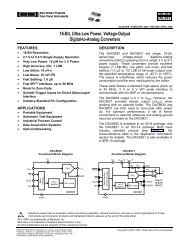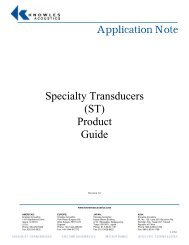AD7714* 3 V/5 V, CMOS, 500 µA Signal Conditioning ADC - dreamm
AD7714* 3 V/5 V, CMOS, 500 µA Signal Conditioning ADC - dreamm
AD7714* 3 V/5 V, CMOS, 500 µA Signal Conditioning ADC - dreamm
You also want an ePaper? Increase the reach of your titles
YUMPU automatically turns print PDFs into web optimized ePapers that Google loves.
AD7714<br />
ON-CHIP REGISTERS<br />
The AD7714 contains eight on-chip registers which can be accessed via the serial port of the part. The first of these is a Communications<br />
Register which controls the channel selection, decides whether the next operation is a read or write operation and also decides<br />
which register the next read or write operation accesses. All communications to the part must start with a write operation to the<br />
Communications Register. After power-on or RESET, the device expects a write to its Communications Register. The data written<br />
to this register determines whether the next operation to the part is a read or a write operation and also determines to which register<br />
this read or write operation occurs. Therefore, write access to any of the other registers on the part starts with a write operation to the<br />
Communications Register followed by a write to the selected register. A read operation from any other register on the part (including<br />
the output data register) starts with a write operation to the Communications Register followed by a read operation from the selected<br />
register. The communications register also controls channel selection and the DRDY status is also available by reading from the<br />
Communications Register. The second register is a Mode Register which determines calibration mode and gain setting. The third<br />
register is labelled the Filter High Register and this determines the word length, bipolar/unipolar operation and contains the upper 4<br />
bits of the filter selection word. The fourth register is labelled the Filter Low Register and contains the lower 8 bits of the filter selection<br />
word. The fifth register is a Test Register which is accessed when testing the device. The sixth register is the Data Register from<br />
which the output data from the part is accessed. The final registers allow access to the part’s calibration registers. The Zero Scale<br />
Calibration Register allows access to the zero scale calibration coefficients for the selected input channel while the Full Scale Calibration<br />
Register allows access to the full scale calibration coefficients for the selected input channel. The registers are discussed in more<br />
detail in the following sections.<br />
Communications Register (RS2-RS0 = 0, 0, 0)<br />
The Communications Register is an 8-bit register from which data can either be read or to which data can be written. All communications<br />
to the part must start with a write operation to the Communications Register. The data written to the Communications Register<br />
determines whether the next operation is a read or write operation and to which register this operation takes place. Once the<br />
subsequent read or write operation to the selected register is complete, the interface returns to where it expects a write operation to<br />
the Communications Register. This is the default state of the interface, and on power-up or after a RESET, the AD7714 is in this default<br />
state waiting for a write operation to the Communications Register. In situations where the interface sequence is lost, if a write<br />
operation of sufficient duration (containing at least 32 serial clock cycles) takes place with DIN high, the AD7714 returns to this default<br />
state. Table V outlines the bit designations for the Communications Register.<br />
Table V. Communications Register<br />
0/DRDY RS2 RS1 RS0 R/W CH2 CH1 CH0<br />
0/DRDY<br />
RS2–RS0<br />
For a write operation, a 0 must be written to this bit so that the write operation to the Communications Register actually<br />
takes place. If a 1 is written to this bit, the part will not clock on to subsequent bits in the register. It will stay at<br />
this bit location until a 0 is written to this bit. Once a 0 is written to this bit, the next 7 bits will be loaded to the<br />
Communications Register. For a read operation, this bit provides the status of the DRDY flag from the part. The status<br />
of this bit is the same as the DRDY output pin.<br />
Register Selection Bits. RS2 is the MSB of the three selection bits. The three bits select to which one of eight on-chip<br />
registers the next read or write operation takes place as shown in Table VI along with the register size.<br />
Table VI. Register Selection<br />
RS2 RS1 RS0 Register Register Size<br />
0 0 0 Communications Register 8 Bits<br />
0 0 1 Mode Register 8 Bits<br />
0 1 0 Filter High Register 8 Bits<br />
0 1 1 Filter Low Register 8 Bits<br />
1 0 0 Test Register 8 Bits<br />
1 0 1 Data Register 16 Bits or 24 Bits<br />
1 1 0 Zero-Scale Calibration Register 24 Bits<br />
1 1 1 Full-Scale Calibration Register 24 Bits<br />
R/W<br />
Read/Write Select. This bit selects whether the next operation is a read or write operation to the selected register. A<br />
0 indicates a write cycle for the next operation to the appropriate register, while a 1 indicates a read operation from<br />
the appropriate register.<br />
–12–<br />
REV. B















